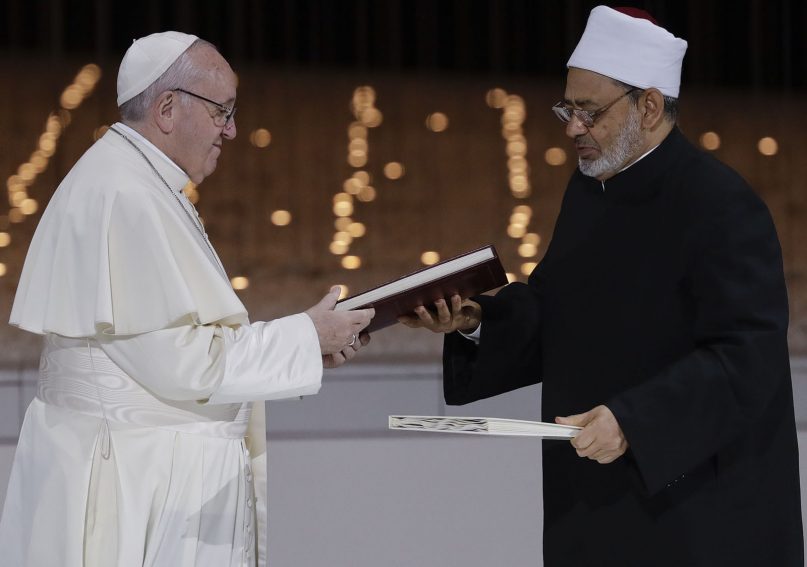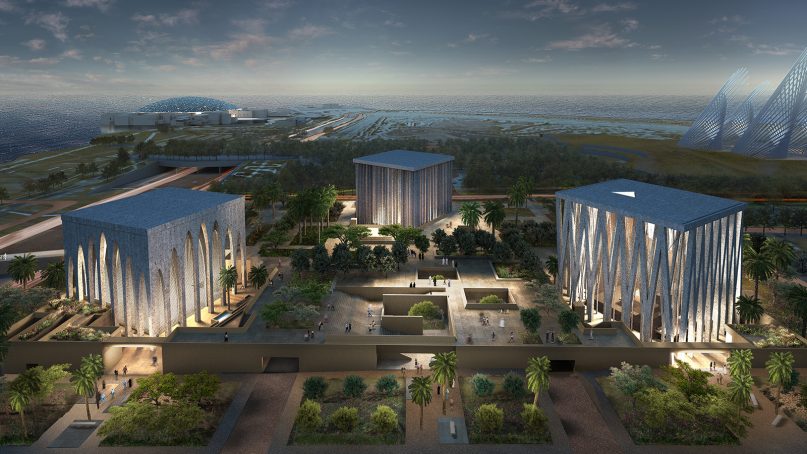
Pope Francis, left, and Sheikh Ahmed el-Tayeb, the grand imam of Egypt’s Al-Azhar, exchange a joint statement on “human fraternity” after an interfaith meeting at the Founder’s Memorial in Abu Dhabi, United Arab Emirates, on Feb. 4, 2019. (AP Photo/Andrew Medichini)
NEW YORK (RNS) — When Pope Francis visited the United Arab Emirates last February, he not only became the first pontiff to step foot on the Arabian Peninsula, but he also stood next to the leading religious figure in Sunni Islam and signed a landmark document pledging all believers to work together for the good of all and against religious extremism.
“Now the impossible has been accomplished!” Francis told Sheikh Ahmed el-Tayeb, grand imam of the Al-Azhar Mosque in Cairo, in an aside heard by a few close aides.
That appears to have been an optimistic take, given the river of unsettling news from the Middle East and around the world since then: rumors of war, fears of climate apocalypse, resurgent nationalism — all of it seemingly exacerbated by religious divisions.
Yet in spite of the challenges, the “Human Fraternity for World Peace and Living Together,” as the initiative is known, has pushed ahead with unusual speed for such high-concept plans, holding its first meeting with Francis at the Vatican on Sept. 11, a date chosen to mark the 9/11 anniversary.
The initiative has now followed up with its most visible and concrete gesture yet, as Catholic, Jewish and Muslim representatives came to New York on Sept. 20 to unveil plans for a church, synagogue and mosque on Saadiyat Island in Abu Dhabi, capital of the UAE.

An aerial night view rendering of the proposed Abrahamic Family House, including a mosque, from left, church and synagogue, on Saadiyat Island in Abu Dhabi. Image courtesy of Adjaye Associates
The three houses of worship, collectively known as the Abrahamic Family House, will stand together as a symbol of the kind of religious tolerance that the UAE wants to be known for and is meant to be seen as a sign of hope.
“There is a wounded humanity today, we see this dark moment of history, with so much hate speech, fake news, the culture of insult and blaming the other,” Archbishop Miguel Angel Ayuso Guixot, head of the Vatican’s office for interreligious dialogue, told Religion News Service. “How do we heal this wounded humanity? I think we have, with this document, a path forward.”
Ayuso, whom Pope Francis will elevate to the rank of cardinal on Oct. 5 in Rome, noted that the document on Human Fraternity and the construction of the Abrahamic Family House was not a theological dialogue but an invitation to “all people of good will” to live together in peace.
As an example, the document specifically invites nonbelievers as well as believers of all faiths to join the initiative.
“This document was a decision to make a change,” said Mohamed Khalifa Al Mubarak, a top Abu Dhabi official and member of the so-called Higher Committee charged with implementing the Human Fraternity initiative. Mubarak noted that the presence of Francis and el-Tayeb together to sign the document was major news in itself. But the follow-through is what will make the difference.
“A major differentiating factor is that we are action-based,” he said. “To have the Abrahamic House in the Arab world, in the Muslim world, showcasing that in this part of the world — where all the news is about hate and darkness, pushing an agenda of division — we are basically planting a beacon of light.”
Rabbi M. Bruce Lustig, senior rabbi at Washington Hebrew Congregation in Washington, added: “We need to put hope over hate and faith over fear at a time when no religious faith or institution has been immune to the type of violence we have seen.”
Lustig and Mubarak were among the Higher Committee members at the unveiling of a model of the Abrahamic Family House at the New York Public Library — an event that symbolized both the high-profile glamour and the captivating aesthetic of the Human Fraternity initiative.
A meeting room inside the grand library had been completely redecorated to resemble a tent-like majlis — akin to a parlor and often adorned with pillows for seating — which is a traditional feature of Arab homes and is where visitors are welcomed. Hundreds of guests across the faith spectrum mingled and drank fruit juice ‘mocktails’ and nibbled on dates and pistachios.
Sir David Adjaye, a rising star architect who designed the $540 million National Museum of African American History and Culture on the National Mall in Washington, won the competition to design the three houses of worship in the Abrahamic Family House. The Tanzania-born Adjaye was there and unveiled a scale model of the project, which is set to be completed in 2022.
The church, the temple and the mosque are not going to be museum pieces or tourist attractions but are instead aimed at serving the religiously diverse population of the UAE, where the huge influx of migrant workers means there are hundreds of thousands of Christians — largely Catholics — as well as members of other religions, including an active Jewish community that numbers about 3,000.
For all the good will and elegant surroundings, however, one notable development since the pope and the imam signed the Human Fraternity document is the opposition from within the respective faith communities — a counterpoint to the comity among them.
Pope Francis, in particular, faced a sharp pushback from some Catholic traditionalists who accused him of indulging in syncretism — the merging of all beliefs into one — by signing on to this initiative.
But the Vatican delegates said Francis made it clear that each faith retains its own identity, and, as Cardinal-elect Ayuso put it, “there should be equal dignity for everyone.”
“This will not become a melting pot but a rich mixed salad!” said Ayuso, a native of Spain.
Msgr. Yoannis Lahzi Gaid, a Coptic Catholic priest from Egypt who serves as a personal secretary to Francis, added that the criticism is welcomed as a chance to clarify concerns. “In Arabic we have a saying, ‘The palm that you hit with rocks is the one that drops good dates.’ So the criticism is evidence of the strength of the document,” Gaid said.
Rabbi Yehuda Sarna, a New York-based rabbi who last March was installed as the first Chief Rabbi of the Jewish Community of the UAE, was also at the unveiling last Friday and said having the event in New York wasn’t just about selling the UAE as an oasis of tolerance; it was also, he said, about sending a signal to the United States as well.
“I think as Americans we need to use this (event) as an opportunity to hold up a mirror to ourselves: what are we doing about religious tolerance?” Sarna said. “At the grass-roots, yes, it’s largely there. But on the national level? I would use this as a mirror. How does this reflect back on me?”




